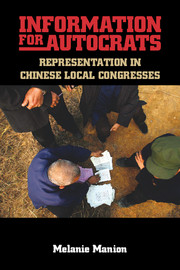Book contents
- Frontmatter
- Dedication
- Contents
- Tables and Figures
- Acknowledgments
- Introduction
- 1 Institutional Design
- 2 Selectoral Connection
- 3 Authoritarian Parochialism
- 4 Putative Principals
- 5 Independent Candidates
- Conclusion
- Appendix A Interviews and Surveys
- Appendix B Reliability Check on Delegate Self-Reports
- Appendix C Searching Independent Candidates on Sina Weibo
- Works Cited
- Index
- Miscellaneous Endmatter
1 - Institutional Design
Published online by Cambridge University Press: 05 December 2015
- Frontmatter
- Dedication
- Contents
- Tables and Figures
- Acknowledgments
- Introduction
- 1 Institutional Design
- 2 Selectoral Connection
- 3 Authoritarian Parochialism
- 4 Putative Principals
- 5 Independent Candidates
- Conclusion
- Appendix A Interviews and Surveys
- Appendix B Reliability Check on Delegate Self-Reports
- Appendix C Searching Independent Candidates on Sina Weibo
- Works Cited
- Index
- Miscellaneous Endmatter
Summary
Congresses in the People's Republic of China were first elected in 1953 and then dissolved in 1966 with the onset of the Cultural Revolution. They reemerged only in the late 1970s as part of a broad post-Mao exercise in building institutions to constrain powerful dictators. Post-Mao congresses differ somewhat in design from the version worked out in the 1950s, soon after the communists won power. The design also changed over time, so it is different now not only from its earliest antecedent but also from the version inaugurated in the late 1970s. Rulers in Beijing made these design choices. The configuration of features that further (and also frustrate) a correspondence between “what citizens want and what policy makers do” (Powell 2004, 273) defines a distinct model of Chinese congressional representation. This chapter describes these features to begin to illuminate the underlying model, the actual workings of which I investigate in Chapters 2 through 5.
The most obvious features of Chinese congressional design are striking reflections of autocracy. A single Communist Party monopolizes organized political power in China, enforcing a ban on political organizations outside the party and on political factions within it. Party-led election committees vet nominees and decide which names appear as candidates on ballots. Local authorities routinely harass independent candidates and ensure their names rarely appear on ballots. The law places serious limits on electoral campaigning; in practice, most local authorities routinely impose even more serious restrictions. Only township and county congresses emerge from popular elections; others are elected, tier by tier, by congresses one level down in the territorial hierarchy. In large part as a result of these features, communists by far numerically dominate all congresses, from the National People's Congress (NPC) down to the township congresses (Interview 17-0503). In the aggregate, by congress level, recent figures on Communist Party majorities range from 68 to 74 percent (Shi, Guo, and Liu 2009, 290), depending on congress level, with the proportion of communists lowest in township congresses. Finally and not least of all, the congresses are mostly large amateur assemblies that meet infrequently and briefly. They typically ratify policies already worked out by a much smaller governing elite.
The underlying model of congressional representation that emerges from the description in this chapter is more nuanced than is suggested by the enumeration of these features, however.
- Type
- Chapter
- Information
- Information for AutocratsRepresentation in Chinese Local Congresses, pp. 25 - 48Publisher: Cambridge University PressPrint publication year: 2015



